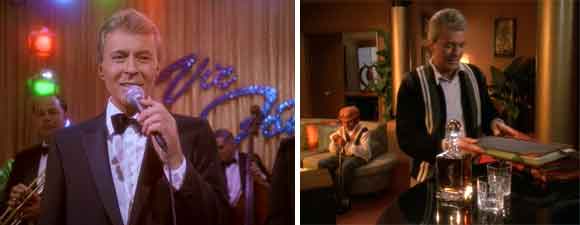Retro Review: Rapture
8 min readSisko sees visions of a Bajoran archaeological mystery which may hold the key to Bajor’s future as well as its past, but the experience threatens to kill him.
Plot Summary: After getting to see a Bajoran artifact depicting the lost city of B’hala on Bajor, Sisko designs a holographic program that allows him to study the model’s spire up close. A holosuite accident injures him and leaves him having hallucinations, beginning with unseen markings on the obelisk, which Kira tells him sound like sacred visions from the Prophets. Admiral Whatley signals the station with the excellent news that Bajor has been admitted to the Federation, but Sisko is distracted, trying to recreate the lost city based on what he has seen. When Kasidy Yates arrives, uncertain of her welcome after her time in prison, Sisko immediately asks her to go to Bajor with him, for his is certain that he has uncovered the location of the lost city. Though he suffers from headaches that he refuses to let Bashir treat, he discovers B’hala and is celebrated all over Bajor, even by Kai Winn, who admits to Kira that she has never fully believed before the he was the Emissary. When Whatley arrives for the ceremony to welcome Bajor into the Federation, Sisko is still on the planet, insisting that his visions have something important to reveal to him. Whatley is unhappy and Bashir is concerned about the headaches, but Sisko insists on seeing the visions through, shocking several Bajorans by revealing prophetic powers to understand and help them. Though the headaches are agonizing, he asks Winn to help him consult the Orb of Prophecy to understand his role. When an impatient Whatley begins the Federation ceremony, he is interrupted by a wild-eyed Sisko who insists that if Bajor becomes part of the Federation now, it will be destroyed. While Bashir persuades Jake that as next of kin, he must decide whether to overrule his father’s wishes and permit the surgery that will save his life, Bajor’s ministers decide to postpone joining the Federation. Sisko is anguished to have lost the visions, but grateful to have his life with Jake and Kasidy.
Analysis: “Rapture” is one of those episodes that I thought was pretty good the first time I saw it and now think is an absolute masterpiece. I know people compare it to Next Gen‘s “Inner Light,” in which Picard too sees visions of a different life, but I think it’s much more important than that. After “The Inner Light,” Picard was left with memories of a lost people and the ability to play a musical instrument from their culture. After “Rapture,” Sisko has fully accepted the implications and consequences of his role as Emissary, while both Bajoran and Starfleet leaders have reluctantly been forced to accept it as well. He has also reaffirmed his connection to the woman who will eventually become his wife – a relationship of which it would seem the wormhole aliens approve, since she is his only companion when he discovers B’hala – and received a reminder that no matter what Bajor and the Prophets may require of him, his son is not ready to let him go. The exploration of faith on Deep Space Nine is extraordinary not just for Star Trek, but for television, and I can’t think of a more interesting or powerful arc than Benjamin Sisko’s as he slowly comes to accept that the wormhole aliens, who are worshipped as gods by the Bajorans, who have powers so far beyond those of humanoids that they can interfere with history, have singled him out for a role he may never understand and which may cost him his life. I’ve never seen a Christ figure to whom I could relate as a person, whether it was Scorsese’s very human Jesus in The Last Temptation of Christ – I’m embarrassed to say that Andrew Lloyd Webber and Tim Rice touched me more with Jesus Christ Superstar – or Monty Python’s parody in Life of Brian, but Sisko’s gradual understanding that he has been chosen for a messianic mission he may never fully comprehend, and his acceptance of what that will do to his life as a man and a Starfleet captain, is extraordinarily thought-provoking and moving.
Okay, so there are some moments that make me giggle, like Sisko building the Devil’s Tower out of fruit a la Close Encounters of the Third Kind. I didn’t like that when I first saw “Rapture,” I thought it was meant to be mocking, but the series needs that humor, and Sisko needs to keep his sense of humor as well or he’ll turn into Kirk shouting “I am Kirok!” We get to see many of Avery Brooks’ brilliant, subtle shadings to the character here, from the confused paternalism toward his increasingly adult son to the conflicted desire for a woman who betrayed him personally and professionally all while professing to love him. He’s remarkably even-tempered for a man suffering from excruciating headaches and confusing visions, and he manages not to look ridiculous in the role of soothsayer when he tells Bajoran followers what he can see of their futures. He has so much on his plate – family, love, duty, friendship, faith – that I wonder whether the jambalaya he loves, that mixed-culture, spicy dish which can be modified to encompass the ingredients available in the cook’s time and place, is meant to be a metaphor. I had wondered whether we were going to get a big scene when Kasidy returned with Sisko declaring soap-opera style that he didn’t know whether he could let go of the past, but the writers instead opt to suggest that he’s had those arguments quietly with himself and by the time he sees her again, he’s ready to invite her back into his life with the slate wiped clean. The fact that she and Jake have their own connection (and that Cirroc Lofton and Penny Johnson have very nice chemistry) makes that easier to believe. The Star Trek franchise as a whole has done such a rotten job with romantic relationships that it’s wonderful to see this one unfolding without the kinky undertones of Dax’s with Worf or the enormous complications of Odo’s with Kira. Speaking of whom, it’s extremely odd that the First Minister of Bajor would not come visit his girlfriend at this moment of enormous change for Bajor – and a moment when his own role is being eclipsed by that of her commanding officer, friend, and Emissary.
My biggest issues with “Rapture” when it first aired had to do with Kira. It’s so strange to hear her passionate defense of the Federation to a dubious Kai Winn, and somewhat embarrassing to hear the Kai rightly put Kira in her place, believing that the Kai lacks courage because she fought the Cardassians with the faith that is now so central to Kira’s life instead of with weapons. Winn has many faults, but cowardice isn’t one of them. Her selfishness will always be her weaknesses, and we see it on full display here – she isn’t concerned that she may have upset the Prophets, she’s concerned that she may have upset Sisko, which would be very bad for her ambitions – but it’s precisely that desire to appear to do more and know more than anyone else that makes her both protective of the Emissary when his headaches threaten his health and to aid him on his spiritual journey as a trained servant of the Prophets. Her reasons for thinking it may be too soon for Bajor to join the Federation are solid ones – self-serving, perhaps, in that she wants no other masters, but nonetheless very similar to the things Kira said when Starfleet first arrived. Where is that Kira, the woman who told Opaka she had always had to wrestle with her belief in the Prophets who let the Occupation continue, who told Bareil how hard it was for her to align orthodox belief with the realities of a rapidly-changing universe? I love the idea that she can grow and change like Winn claims to have done, but we deserve to see it happen. These days she’s calling Sisko “Benjamin” instead of “Emissary” when they’re discussing their private beliefs; is that because his role as her friend is now as important to her as his role on Bajor, even though he doesn’t invite her along with his girlfriend when he makes an archaeological discovery that will mean so much to Bajorans? It seems a weird reversal to have Sisko pleading on behalf of Bajorans to keep Bajor out of the Federation after Kira has rationalized that the Emissary is the very reason she now believes Bajor should join.
If Sisko and Kira represent all that can be good about faith, particularly in this scientific context where identifiable beings with a proven ability to transcend time and space are involving themselves in the affairs of less powerful sentient humanoids, then Winn represents all that remains dangerous and problematic about it. Her revelations about her past as a prisoner of the Cardassians makes me rethink all that we know about her – a woman who may not have held a weapon herself, yet who deputized a faithful Bajoran follower to assassinate a rival for Kai. Then, I presumed that she was using the Prophets as a tool to manipulate Neela into shooting Bareil. Now, it seems likely that Winn truly believed that she was doing the work of the Prophets, knocking aside an unorthodox heretic who was about to ascend to her world’s highest religious post. To me, that’s even scarier than a person scheming to take power for herself by any means necessary. She wants to be doing the work of the gods, she believes that she is doing the work of the gods, and that makes it possible for her to rationalize any manner of atrocity as justifiable. It’s easy to imagine her sending bombers into school buildings or gunmen into medical clinics while keeping that smug, self-righteous smile on her face. The fact that she is as relatable as Sisko – that Louise Fletcher plays her as someone we could recognize from real-world politics, that we’ve seen her personal relationships – makes her all the better, though I found her defanged when I first watched “Rapture” and was missing her villainous scheming. It surprises me that she wants to save Sisko’s life rather than learn what the Prophets might show him and run with that knowledge in his absence. Perhaps, like Jake and like Kira, she appreciates how valuable Sisko is as a man, setting aside his increasingly complex role as the Emissary and the conflicts that creates with his position in Starfleet. It’s not the last time he’ll be torn between them.







…and they started using the new “First Contact” uniforms here. He also mentions “the coming war with the Dominion.” The Bashir that was in this episode was a Changeling.
Normally, I’d assume that the writers weren’t on the same page regarding Bashir being replaced by a Changeling as far back as “Rapture”. “In Pugatory’s Shadow” was co-written by DS9 showrunner Ira Steven Behr and he wouldn’t have made such a careless error in having the real Bashir in the earlier DS9 uniform. Though a non-canon novel suggested Bashir was replaced shortly before “Purgatory”, the prevailing assumption is he was replaced before “Rapture”.
I loved this episode and this arc. I remember the joy I felt. It’s hard to explain, and I have friends who never “got” Deep Space Nine, and that frustrates me. But I loved that the story was NOT “Unsophisticated (not as a smart as we are ) species thinks Starfleet officer is emissary of the Bajoran prophets,” and NOT “Starfleet officer is mentally deranged or taken over by alien force and believes he’s the emissary of the Bajoran prophets,” but “Normal, not psychotic, not possessed Starfleet officer from New Orleans…somehow…IS the emissary of the Bajoran prophets.” It was a huge step in Star Trek, which has so often presented “alien” species as lesser than humans, especially the alien species with religious beliefs. At its best, ST:DS9 was so good. Those arcs, those wonderful story arcs! Dukat appearing and reappearing, practically every decision coming back on the characters later, having to deal with anything and everything that blew out of the wormhole at them, multiple species existing together, religions, Starfleet NOT turning the promenade into a squeaky clean Starbase, the Bajorans trying and not succeeding to put themselves back together as a people after the Occupation, real relationships between ongoing main characters…oh, I love this show.
Agreed.
Fab Five Freddie told me everybody’s fly,
DJ’s spinning, I said my, my!
Flash is fast, Flash is cool,
Francois sais pas, Flashe no deux,
And you don’t stop, sure shot,
Go out to the parking lot,
And you get in your car and you drive real far,
And you drive all night and then you see a light,
And it comes right down and lands on the ground,
And out comes a man from Mars!
And you try to run but he’s got a gun,
And he shoots you dead and he eats your head,
And then you’re in the man from Mars,
You go out at night, eatin’ cars,
You eat Cadillacs, Lincolns too,
Mercuries and Subarus,
And you don’t stop, you keep on eatin’ cars,
Then, when there’s no more cars
You go out at night and eat up bars where the people meet….
Happened to watch this again over the weekend after reading this review, and one thing stood out for me: what was the point of that scene where Odo arrests Quark for the poor maintenance on his holosuites? Nothing ever comes of it. The next time Quark is seen is at the bar celebrating the admittance of Bajor into the Federation, and the arrest is never mentioned again. It seems like a complete waste – maybe the show was running short and they needed filler?
Well the Captain got better, so the charge was probably dropped.
Yes, that would be the in-show explanation, but doesn’t explain why the writers included this scene in the first place. It must be that either the show was running short and they needed filler, or the show was running long and every other part dealing with the arrest was cut.